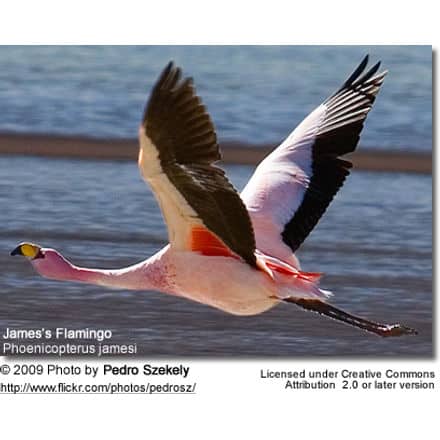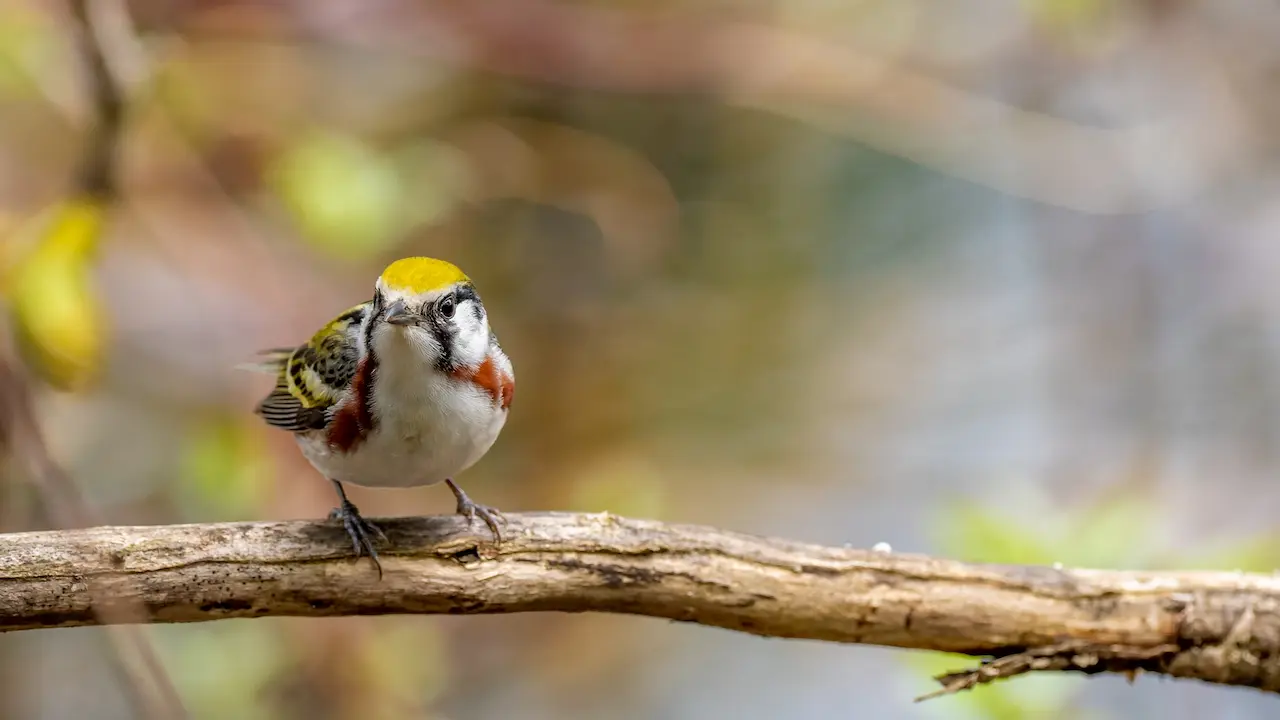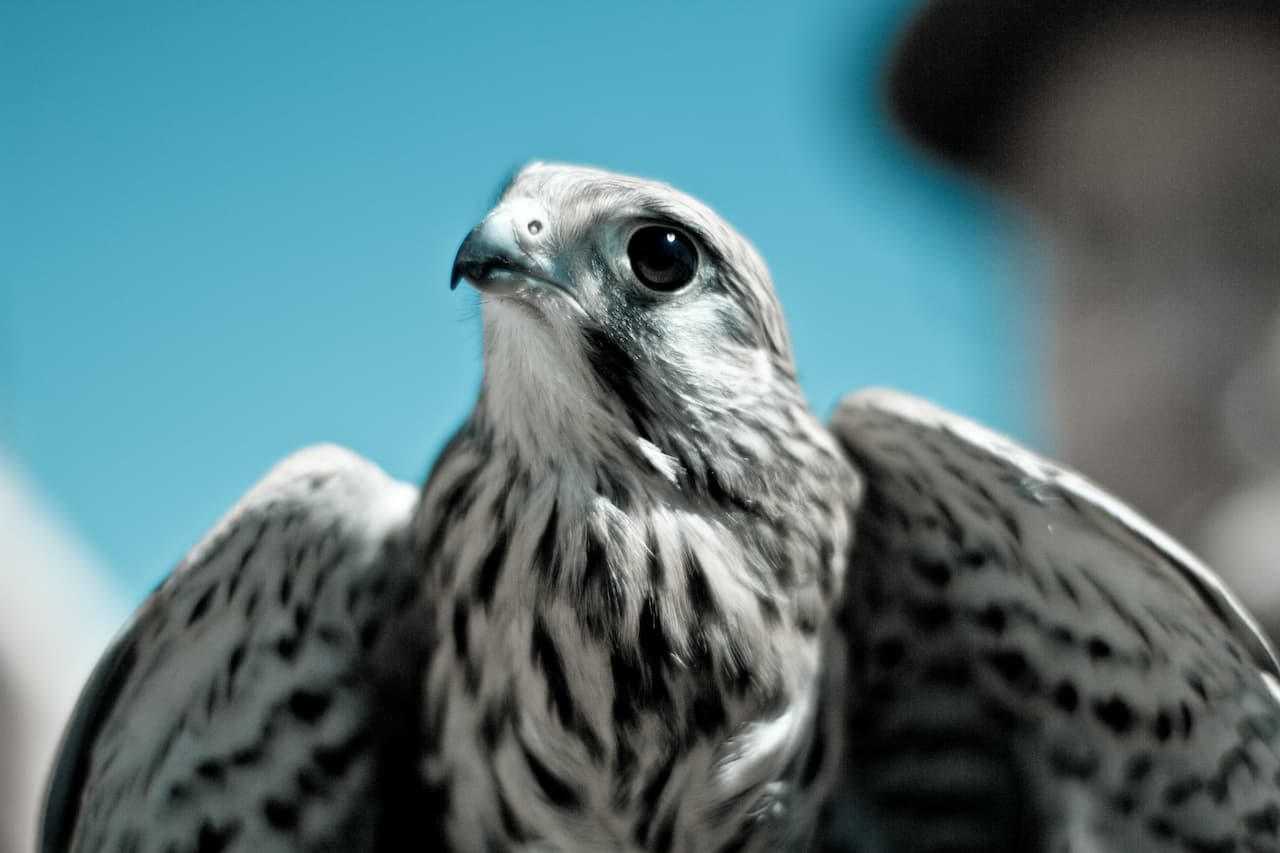James’s Flamingo (Phoenicopterus jamesi)
The South American Puna Flamingos (Phoenicopterus jamesi) are also known as James’s Flamingos (so named for Harry Berkeley James) and Lesser Andean Flamingo.
It received its common name “Puna” from its natural habitat – “puna” is the local word for high Andean plateau. The name “Flamingo” was derived from the latin word for “flame,” in reference to this species’s flame-colored plumage. The flamingo’s characteristic pink / salmon-colored plumage is caused by their beta carotene-rich diet.
The Puna Flamingo is closely related to the Andean Flamingo, and those two – in addition to the Chilean Flamingo – are the only flamingos native to South America.
The Puna Flamingo is classified as Near Threatened following rapid declines in their numbers during the twentieth century due to destruction or deterioration of their natural habitat.
Its maximum lifespan is about 40 years.
Alternate (Global) Names
Chinese: ???? … Czech: Plamenák Jamesuv, plame?ák James?v … Danish: Punaflamingo … Dutch: James’ Flamingo, James-flamingo … German: James Flamingo, Jamesflamingo, James-Flamingo, Kurzschnabelflamingo … Estonian: lühinokk-flamingo … Finnish: Punanflamingo … French: Flamant de James… Hebrew: ????? … Italian: becco corto, Fenicottero del James, Fenicottero della puna, Fenicottero di James … Japanese: kobashifuramingo … Lithuanian: Puna flamingas … Norwegian: Punaflamingo … Polish: flaming krótkodzioby … Russian: ????????????? ????????, ???????? ???????, ???????? ?????? … Slovak: plameniak krátkozobý … Spanish: Parina chica … Swedish: Punaflamingo
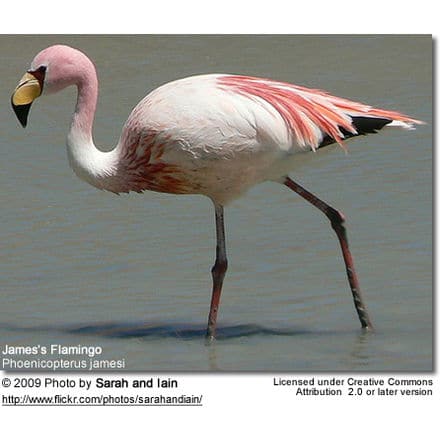
Distribution / Range
The Puna Flamingos occur on the high Andean plateaus of Peru, Chile, Bolivia and Argentina where they usually occur at altitudes of over 3,000 m (9,900 ft).
Together with the other South American flamingos — namely the Andean Flamingos and Chilean Flamingos, they inhabit salt lakes and lagoons in the Andean mountains, After the breeding season, most migrate to lower attitudes for the winter. Some remain at lakes near hot springs.
Argentina: Smaller populations are found around the lowland Laguna Mar Chiquita in Argentina. Some breed at Lagunas de Vilama and Laguna Grande.
Bolivia: The most popular breeding territory appears to be Lagunas Colorada and Guayaques, where up to 41,000 birds have been recorded.
Chile: One colony settled in Salar de Tara in Chile.

Description
This smallish flamingo stands about 1 meter (3.25 feet) tall and has a wingspan of about 1 meter (3.25 feet). It weighs about 4.5 lbs (2 kg).
The plumage ranges from whitish to pale pink, with bright darkish pink streaks around the neck and on the back, and some black wing feathers.
It has bright red skin around the eyes. The thin legs are dark red and the downward curving bill is bright yellow with a black tip. It has a long neck
Immature birds have a greyish plumage, but their plumage slowly turns pink as they mature.
Similar Species:
James’s Flamingo resembles the Chilean Flamingo; however, the latter is pinker and has a longer bill without yellow; and the Andean Flamingo, which is larger in size, has yellow legs and has more black in the wings and bill.
Breeding / Nesting
Puna Flamingos nest in large colonies, often together with thousands of other pairs. Even though they are typically non-territorial, they will defend their nest during the breeding season.
Their nest is a mount made of mud and small stones, lined with feathers. It is often situated in shallow water. A nest mound may be as high as 30 cm (12 in); and It can take up to six weeks for a pair to complete the nest.
The female only lays one chalky white egg. The parents share the incubation of this egg, which lasts about 27 – 31 days to hatching.
For about two months, both parents feed the chicks with a substance called “crop milk” that contains various nutrients, such as fat and protein, as well as red and white blood cells. This milk is produced in glands lining the entire upper digestive tract (including the crop). Other flamingos may act as foster feeders.
Chicks usually leave the nest when they are about 4 to 7 days old, they will leave the nest; and often will gather together in creches that are watched over by a few adult birds.
After about two months, their juveniles’ bills should be developed enough to filter feed.
Young flamingos attain their full adult plumage when they are about 2 – 3 years old.
Diet
Puna Flamingos feed on diatoms (blue-green algae) collected in shallow water through which they walk slowly with the bill dipped just below the water surface. Their specialized beaks separate mud and silt and the lamellae (miniature ridges inside the bills of water-feeding birds or “teeth”) in the lower bill together with the large rough-surfaced tongue assist with the filtering of food.
The flamingo’s characteristic pink coloring is a result of the Beta carotene-rich algae.
Calls / Vocalizations
The calls of the Puna Flamingos are described as a loud goose-like honking.
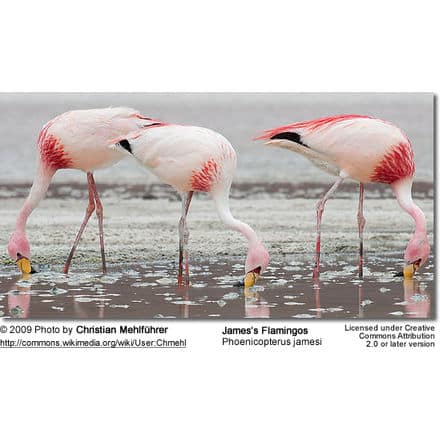
Flamingo Information … Flamingo Species Photo Gallery
